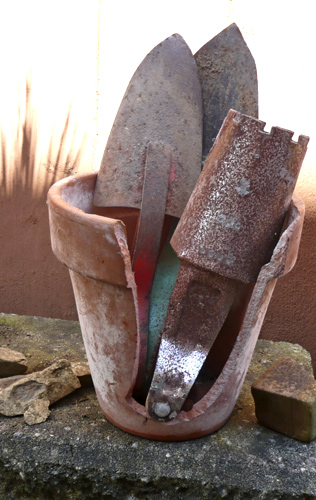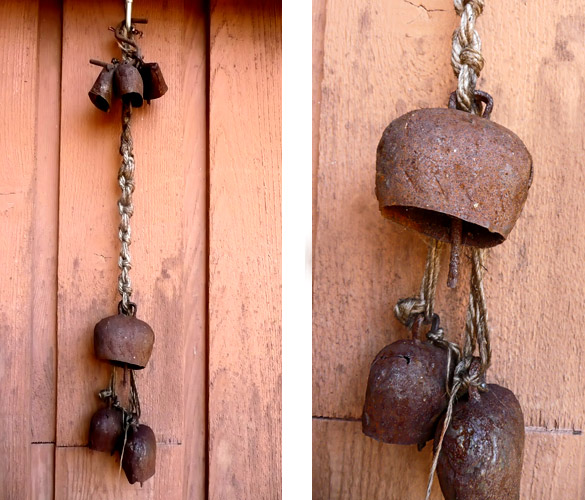an artist’s garden

About a week ago I wrote about some garden art we’d installed to hold up some flowering plants. One commenter in that post mentioned Derek Jarman’s garden in Kent, England, including a link to wonderful photos of it as well as mentioning Jarman’s book. I was immediately captivated.
A few days later, a package arrived at our door, containing the book Derek Jarman’s Garden! It’s a lovely surprise gift by that commenter, J, who is our son-in-law, presently working in England (our daughter and their two girls are visiting here). I knew artist, filmmaker and writer Derek Jarman was a hero of J’s just from seeing his large collection of that artist’s books and films.
I didn’t know that gardening was a life-long passion of Jarman’s and that he spent the last years of his short life building this unique garden at his cottage on the shingle beach of Dungeness, next to a nuclear power plant. He kept a journal about the experience, while photographer Howard Sooley captured rich images of him and the garden, even assisting in plantings. Jarman hunted and carried back many stones, weathered wood pieces and rusty objects from his walks on the shore and created magical installations amongst the plants and shingle. Jarman’s partner Keith Collins wrote a lovely preface and assisted in the publication, done after Jarman’s death.
Only a few hours after receiving the book, and it being a very rainy day, I was drawn into this little beauty, absolutely swept in and loving the photos and the writing, finishing it at bedtime with a happy glow. Here is one of many many favourite passages from Jarman’s writing:
At first, people thought I was building a garden for magical purposes – a white witch out to get the nuclear power station. It did have magic – the magic of surprise, the treasure hunt. A garden IS the treasure hunt, the plants the paperchase.
I invest my stones with the power of those at Avebury. I have read all the mystical books about ley-lines and circles – I built the circles with this in mind. The circles make the garden perfect – in winter they take over from the flowers. There was magic and hard work in finding the coloured stones for the front: white, difficult: grey, less so; red, very rare.
I was amazed at how much beauty was achieved in such a harsh environment. By no means can I compare myself to such a wonderful gardener (as well as writer and artist). I think the lush rainforest of our Pacific Northwest area is one huge garden of its own, in the midst of which we try to make our own little mark, our little piece of paradise on earth. This book has inspired me to look at my garden in a slightly different way, encouraging me to continue to add more personal touches after installing the rust pieces mentioned earlier. I unearthed some forgotten artifacts in the garden shed, like these rusty old garden tools and Greek goat bells, very modest things to add to the various stones and rocks from beaches here and there. Time for more beach and junkyard combing, methinks!
Thank you so much for this inspiring book, J, I will treaure it!
Oh, and isn’t it interesting that this conversation started with the other son-in-law making the wonderful rust garden supports, with daughter Elisa‘s suggestion? I am lucky.

Later: J sent me some excellent links for further reading and viewing if you are interested:
– article by Howard Sooley
– Howard Sooley’s website
– more writing at the Guardian
– a “letter” from Tilda Swinton, the actress, and good friend of Jarman’s mentioned a few times in the book
Plus, I forgot to add this article about the Dungeness area
July 11, 2011 in Being an Artist, Books, Other artists by Marja-Leena
i hope to make a pilgrimage to jarman’s garden. i am so pleased that you two have been talking about this! and that it is leading to more little details in your wonderful garden. i’m very fond of the colourful float you found on the beach once, and i’ve gathered a few of those curious rocks from the island with the many holes in them, for my own collection. xx
Apologies to Susan for your comment was lost in the server crash. You wrote a couple of evenings ago:
It’s getting a bit late for me now to stay and examine the links but I will do so tomorrow. For tonight I’ll just say your fine eye and skill have made a lovely garden already. Having it get better will be a wonder.
Here was my response to both Elisa and Susan which also got lost:
Elisa, I enjoyed the chats with J and I’m so pleased to have learned about Jarman’s garden. Hopefully will see it one day too. As you know a garden is always a work in progress, there is so much that needs to be renewed now that it’s so old.
Susan, you are too kind, not having seen all of my garden as I do show its best moments. I hope you enjoy the links… let me know what you think.
I suppose “harsh environment” does fit though I never saw it that way. Dungeness is perhaps ten miles west of Folkestone which is where Mrs BB’s parents lived and on several occasions we drove over there to walk on the shingle beach. For reasons we were never entirely able to explain.
Once upon a time Folkestone was a swanky sea resort patronised by royalty but it never recovered from WW2. The place went into decay and the decay was replaced by tat. Shabby and irrelevant best describes it. In comparison Dungeness on its stumpy peninsula out into the Channel has an other-worldliness. There are holiday bungalows there, seemingly closed whatever the time of year, and the roads are covered with sand blown by winds typical of the generation and degeneration that defines the area. Along the shoreline this process takes another form as shingle is scooped up by the sea on the western side and deposited on the eastern side – or the other way round. The wayward sand could be quite alarming. Once we drove down there in our Heinkel bubblecar, a lightweight three-wheeler with a tiny engine. As I crossed one of the sand-drifts the wheels were seized and the car lurched away almost at a right-angle.
I can’t ever remember seeing a single person out walking although people did live there despite the nuclear power station. Decades later Mrs BB’s sister and husband bought a house in Dungeness, did it up and then were forced to sell it when an illness in the family prevented them from moving in. Mrs BB always believed her sister regarded this as a great disappointment. But then disappointment and Dungeness seemed like bed-fellows.
For me the place was a perfect antidote to the excesses of Christmas. The ever-present wind and the sense of mild desolation were a long way from the indulgences elsewhere. Inevitably I was unaware of Jarman’s garden at the time and I doubt I would have been tempted. Dungeness didn’t encourage those kind of thoughts. But it did encourage reflection although this tended to be morbid. The closed face of those bungalows could, if you let them, lead you to believe you were the last person alive and that Dungeness was a stepping-off point into the void. Or that Dungeness itself was the void.
But the fact is if we were down that way I’m quite sure Mrs BB would be up for a visit. To see if we could explain satisfactorily to ourselves where the pull came from.
Should you decide to visit I’m sure you will find all of the above romantic nonsense.
BB, having personally visited Dungeness yourself, I’m so glad you wrote about it here. I’m only repeating views made by other writers about the harsh environment – the cold winds of winter in an area of no shelter for instance. There used to be a fishing community there, and some of the pieces that Jarman collected off the beaches came from their long gone boats. “Otherworldliness” sounds just like what Jarman would say, the peace and even desolation seemed to suit him as a place for meditation and connection to the earth, especially when he became ill. Romantic nonsense? I think not.